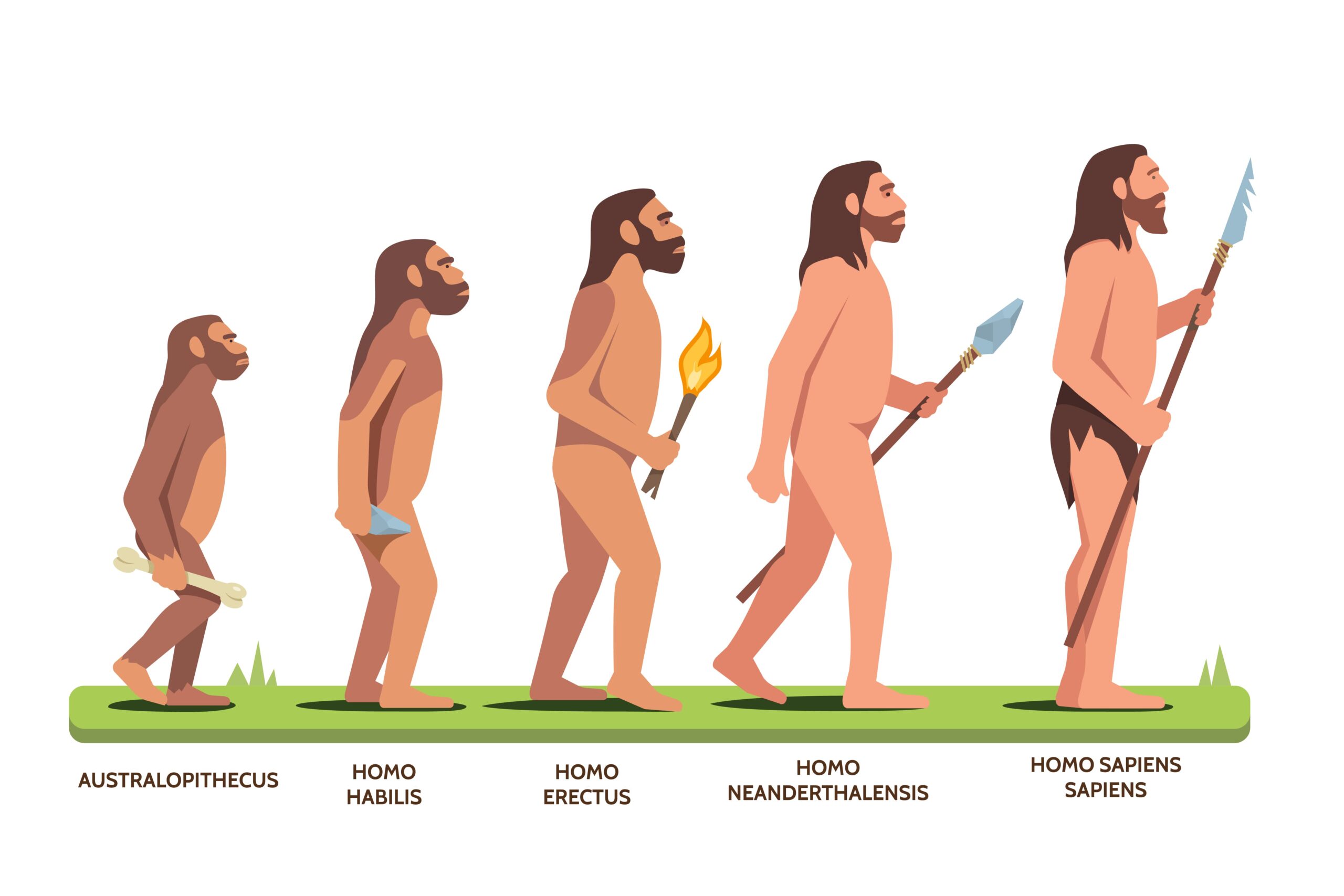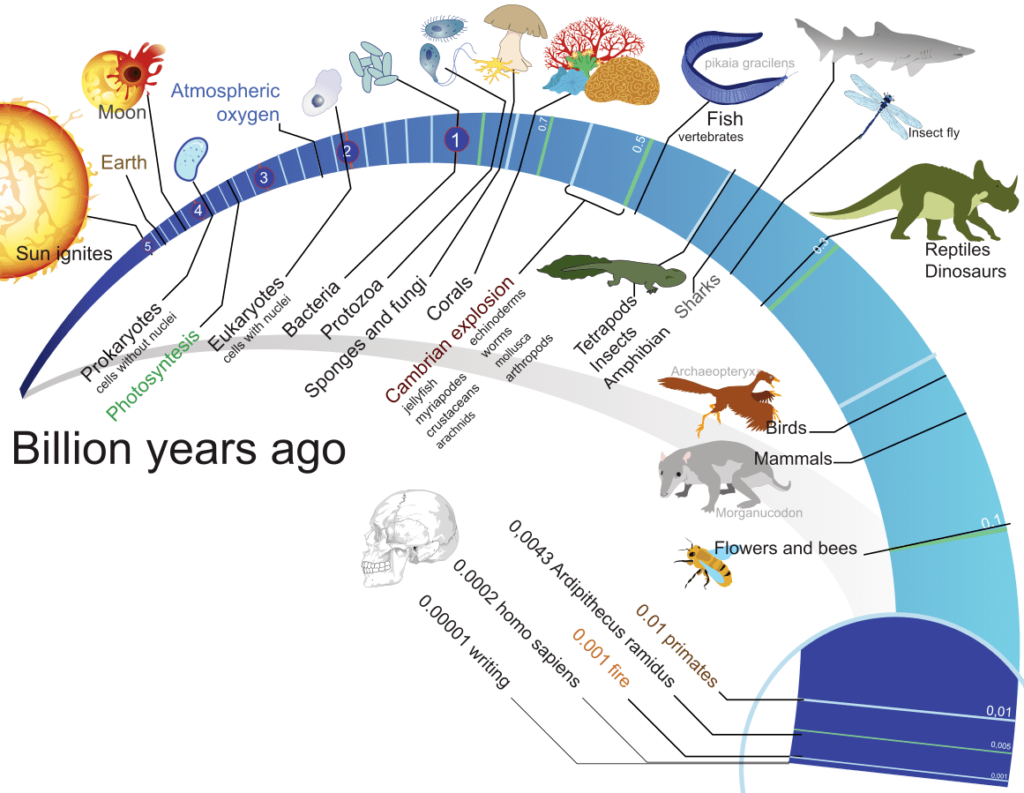Introduction
The origin and advancement in the physical features of human ancestors have been termed human evolution. According to this theory, early humans went through a number of stages which converted them from prehistoric man to modern humans. Gradually the development in their brain size permitted them to use their physical attributes more skillfully. Early humans underwent many changes during the Neolithic period. They changed from hunters and gatherers to food producers, from living in trees or caves to becoming settlers, and from nomads to properly established people. Through this evolutionary process, humans developed the skill of managing resources efficiently and learnt the ability to remain in social work with other unknown individuals.
Evolution
Evolution is the gradual change in the inherited traits of populations over many generations. These traits are the expressions of genes, which are passed down through from parent to offspring during sexual reproduction. This is the process by which a living organism changes and develops from their ancestors. Natural selection, mutation, gene flow, and genetic drift are a few of the methods which bring about evolution in a species. As a result of these processes, species emerge, grow, and adapt to their physical and social environments.
Evolution of Humans
Evolution of humans occurred from apes. Most scientists believe that humans and apes must have developed from the same creature because they share so many characteristics, such as long arms and a large brain. These ape like creatures were called hominids.

Australopithecus Afarensis and Lucy
- The name Australopithecus refers to the earliest hominid. Australopithecus africanus, Australopithecus robustus Boisie, and afarensis are some of the different types of Australopithecus that have been identified through fossils.
- Australopithecus afarensis fossils have been discovered from Etopia.
- Experts have seen the last phase of bipedal movement in this species.
- Despite being able to stand upright, these humans still had certain ape-like characteristics.
- The most well-known Australopith is “Lucy“. It is a skeleton of Australopithecus afarensis which 3 million years ago was discovered in 1974
- It was found by Donald C. Jhonson and his student Tom Gray at the site of Hardar in Ethiopia.
- While looking for animal bones, Johnson and Gray unintentionally discovered a little arm bone fragment and recognized that it belonged to hominids.
Homo Habilis
- The earliest known fossils of Homo are known as “homo Habilis,” and they were found in Kenya.
- The genus homo is different from Australopithecus, as its brain was bigger in size.
- Two million years ago, Homo Habilis possessed a larger brain that was nearly 800 cc in size.
- It was believed that Homo Habilis made various tools.
- They were first classified as members of the australopithecine family, but an in-depth research, later demonstrated that they should actually be considered early human specimens.
Homo Erectus
- A new species known as Homo Erectus emerged after the origin of Homo Habilis.
- It had a larger brain, that was 1000cc in size.
- They were considerably bigger and taller than Homo Habilis and now they could stand straight.
- Their grip improved as their fingers developed and this enabled them to firmly grasp objects.
- They began to travel enormous distances and build tools with great proficiency.
Homo sapiens Neanderthalensis
- Gradually Homo erectus perished nearly around 400,000 years ago.
- Around 125,000 years ago, a new species of Homo appeared on the human evolutionary process the Homo Neanderthals or Homo sapiens Neanderthals.
- In the 20th century, their fossils were discovered in Germany.
- Neanderthal brain continued to grow in size, and evidence of ‘culture’ began to emerge
- However, Neanderthal skulls were very distinct from those of modern humans.
Homo Sapiens Sapiens
- Then emerged the Homo sapiens sapiens, also known as the “thinking man” or “wise man,” from which modern humans evolved.
- They had a 1350cc brain, which allowed them to create more sophisticated tools.
- The homo sapiens sapiens began to interact with their social surroundings and live in groups.
- To dwell longer in a place, they started constructing proper and strong shelters.
- They were likely the first living things to speak what we now refer to as language, and it proved to be helpful for them.
The Neolithic Revolution
- The beginning of the Neolithic period can not be traced to a particular date as it was emerging at different times in different places.
- It is one of the third stages of development and it saw a evolution in the early humans’ way of existence.
- The invention of agriculture was the most significant aspect of this period. Now, they no longer need to go around in quest of food because they have learned to cultivate their own food.
- Permanent settlements were eventually established as a result.
- Along with this, they now started to domesticate animals for their own purposes; this was also the time when the wheel was invented.
Summary
Human evolution is a long process and it took millions of years to transform primitive humans into present-day humans. As per numerous scientific investigations, it is thought that humans have developed from ape-like species. They could not even walk straight and they used to live like animals. As the brain grew in size over time, the evolution of the homo sapiens began. Their social conduct also evolved gradually. Additionally, they developed excellent toolmaking skills. Humans could also store knowledge due to their more advanced brains. This enhanced the speed of cultural adjustment and now modern humans were no more dependent on biological advancements.
Frequently Asked Question
1. What color was the original human being on earth?
Ans: Early humans had a pale skin, similar to the chimpanzee(closest relative of humans), . Dark skin was first a feature of early Homo sapiens which developed between 1.2-1.8 million years ago.
2. How come people have two legs?
Ans: One of the factors, that allowed humans to evolve from their prehistoric ape-like forebears was the ability to walk on two legs. Being able to move around on two legs saved energy and freed up the arms for tasks like hunting, making simple tools, and interacting with objects.
3. Are there still Neanderthals existing?
Ans: Around 430,000 years ago, fossils resembling Neanderthals were first discovered. The earliest Neanderthals are thought to have existed between 130,000 and 40,000 years ago, beyond which no physical proof of them can be found.
